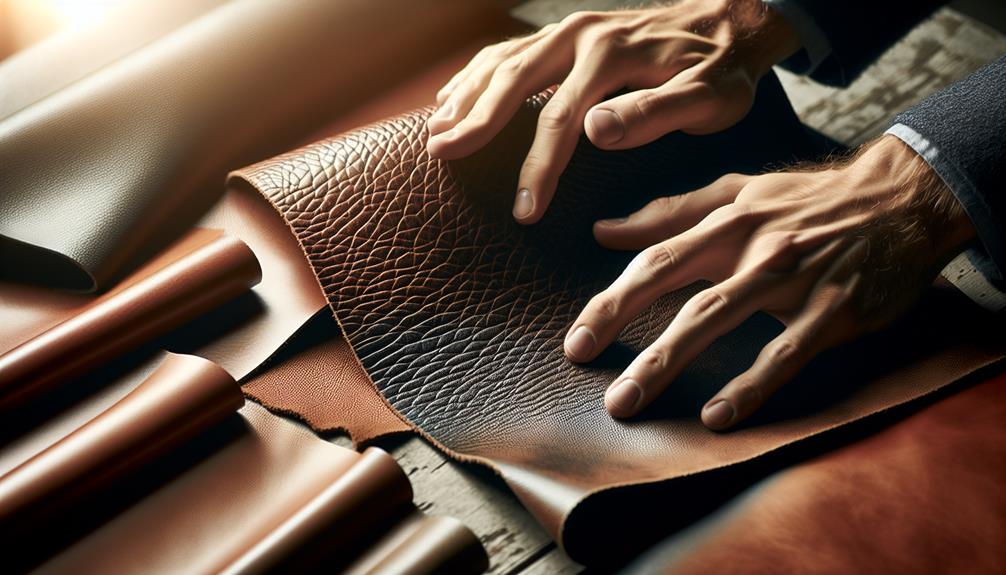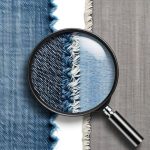I usually start by checking the label for terms like “100% real leather” or “genuine leather.” Real leather feels a bit imperfect and natural, while synthetic types often feel too smooth and rigid. I'll give it a good whiff too because real leather has a distinct, natural scent that fake leather just can't mimic. If I'm still unsure, I might do the water test; real leather absorbs water quickly. Looking at the edges also helps; genuine leather has rough, uneven edges. There's plenty more to learn about identifying real leather, and it's quite fascinating how detailed it gets!
Table of Contents
Key Takeaways
- Check the label for terms like “100% real leather,” “full/top grain leather,” or avoid “synthetic leather.”
- Genuine leather has a natural, irregular grain and may show imperfections.
- Real leather has a distinct, earthy scent, unlike the chemical odor of synthetic materials.
- Observe the edges; real leather edges are rough and uneven, not perfectly smooth.
- Conduct a water test; real leather absorbs water quickly, while synthetic repels it.
Read the Label
When checking for real leather, always start by reading the label. It's your first clue in distinguishing the genuine from the fake. If you spot terms like “100% real leather,” “full/top grain leather,” or simply “genuine leather,” you're likely looking at the real deal. These labels indicate that the item is made from natural leather, a material prized for its durability and texture.
On the flip side, if the label mentions “man-made materials” or “synthetic leather,” these are clear indicators that the product isn't made from real leather but from artificial substances designed to mimic the look and feel of leather. While these synthetic alternatives can be less expensive, they don't offer the same quality or wear as genuine leather does.
Also, be wary if the label doesn't specify the material at all. This absence can often suggest that the manufacturer is trying to conceal the use of synthetic materials. Real leather products tend to be more expensive, and rightfully so, given their superior quality and longevity. So, always take a close look at the label – it tells you more than you might think about what you're actually buying.
Feel the Texture
After checking the label, the next step is to feel the texture of the leather to further verify its authenticity. When I run my fingers over real leather, I can immediately sense its unique qualities. Genuine leather isn't perfectly smooth; it's slightly imperfect due to its natural grain texture. This isn't something you'll find in synthetic versions, which often feel uniformly smooth without any character.
Pressing into genuine leather, I notice how it wrinkles, much like skin, showing off its flexibility and softness. This is a stark contrast to fake leather, which tends to be rigid and doesn't mold to my touch. The warmth of real leather is another telltale sign. It feels warm and alive, adapting to my body heat, unlike faux leather that often feels cold and unyielding.
Conduct a Smell Test
To further verify if your leather is genuine, give it a good sniff and see if it has that distinct, natural leather scent. Authentic leather should hit your nose with an organic scent that's hard to mistake. It's like walking into a room filled with wooden furniture or a freshly tilled garden—there's an unmistakable earthly smell that speaks of nature and the outdoors.
Fake leather, on the other hand, often misses this mark. If what you smell reminds you more of a plastic toy or a freshly opened can of paint, then you're likely dealing with synthetic materials. These tend to emit a chemical odor that genuine leather simply doesn't have.
Here's a quick table to help you make sense of what you might be smelling:
| Scent Type | Real Leather | Fake Leather |
|---|---|---|
| Natural Aroma | Earthy, woodsy | Absent |
| Chemical Odor | Absent | Prominent |
| Organic Scent | Distinct, musty | Lacking |
| Plasticky Smell | Non-existent | Often noticeable |
| Overall Impression | Rich, inviting | Artificial, harsh |
Examine the Grain
When checking out leather, first look for natural imperfections in the grain; these irregularities are a good sign it's real.
Next, run your fingers over the surface to feel for any texture variations—smooth in some spots and rough in others can indicate authenticity.
Lastly, don't forget to give it a sniff; genuine leather has a distinct, rich smell that fake leather can't quite replicate.
Identify Natural Imperfections
Let's dive into how you can spot real leather by checking out the grain for natural imperfections like wrinkles and scars. When you're examining a leather item, look closely at the grain. Here's what you should watch for:
- Wrinkles and Scars: Genuine leather will exhibit these marks, reflecting its organic origin.
- Unique and Irregular Patterns: Unlike synthetic materials, real leather will have a grain that's not perfectly uniform.
- Creases and Blemishes: These aren't defects but rather authentic signs that you're dealing with real leather.
These natural imperfections are key indicators of genuine leather. They give each piece a unique, organic appearance that synthetic alternatives simply can't replicate.
Feel for Texture Variations
Feeling the texture of leather can instantly tell you a lot about its authenticity. When I run my fingers over genuine leather, I notice a variety of texture variations. It's not just smooth; there's a grainy feel, slight stretchiness, and sometimes, a softness that faux leather can't mimic.
Real leather often has inconsistent surface grains, which are a tell-tale sign of its realness. Each piece has its own unique texture, complete with imperfections that synthetic materials just don't have. On the other hand, faux leather feels too uniform, lacking this natural diversity.
Smell the Leather
One quick sniff of leather can reveal its authenticity, as real leather emits a distinct, earthy scent unlike the chemical smell of faux alternatives. When I smell the leather, here's what I usually look for:
- Organic Scent: Genuine leather has a natural aroma that reminds you of where real leather is made—from animal hide.
- Earthy and Musty Notes: Unlike synthetic materials, leather smells distinctly earthy and sometimes musty, a sign of true authenticity.
- Absence of Chemical Odor: Real leather lacks the harsh chemical odors common in faux leather, making it easier to differentiate.
This simple test helps me ensure I'm getting the real deal, appreciating the natural qualities that genuine leather offers.
Perform a Water Test
When I'm checking if leather is real, the water test is super handy.
I just drop a bit of water on the surface and watch how fast it gets soaked up.
Real leather absorbs water quickly and the surface darkens, showing off its natural pores.
Water Absorption Rate
To test if you're dealing with real leather, try the water absorption method: simply drop a bit of water on it and see if the material absorbs it, leaving a dark spot. This water test is a simple yet effective way to distinguish between real and fake leather. Here's why it works:
- Porous Nature: Real leather, due to its natural, porous properties, absorbs water, which helps in verifying its authenticity.
- Observation: Carefully observe how the water behaves. Real leather absorbs water and darkens, showing it's genuine.
- Fake Leather Reaction: Fake leather usually repels water, causing it to pool on the surface without being absorbed.
This test is a handy trick to ensure you're getting the real deal!
Surface Reaction Details
Let's dive deeper into how the water test works by examining the surface reaction of the leather. When you place a drop of water on real leather, its material composition allows it to slowly absorb water. This is a key indicator of its authenticity.
In contrast, fake leather tends to repel water, causing the droplets to bead up and sit on the surface, without any absorption. This moisture interaction test is super handy to distinguish between the two.
Try the Flame Test
One quick way to tell if you've got real leather is to try the flame test. It's a simple, effective method that helps confirm the authenticity of leather materials.
Here's how it works: real leather and synthetic leather react differently when exposed to flame. Genuine leather chars slightly and gives off a distinct burnt hair smell, which is quite telling since it's made from animal hide. On the other hand, synthetic leather, which is essentially plastic, will catch fire more quickly and emit a chemical odor.
To get started with the flame test at home, follow these guidelines:
- Safety First: Make sure you're in a safe area with no flammable materials around.
- Quick Contact: Briefly expose the leather to a small flame.
- Observe Reactions: Watch for how the material reacts and smells.
Assess the Edges
Examining the edges of a piece of leather can quickly tell you if it's the real deal or just a good imitation. When I look at real leather, I usually find the edges to be somewhat rough and uneven. This is because genuine leather retains the natural irregularities of the animal hide it's made from.
In contrast, if the edges are too perfect, too smooth, and feel like they've been cut by a machine, there's a good chance you're looking at synthetic leather. Manufacturers of faux leather tend to ensure the edges are uniformly smooth to mimic a flawless finish, but this often misses the mark on authenticity.
The rough edges of genuine leather aren't just about aesthetics; they speak volumes about the craftsmanship involved in its creation. Each uneven edge tells a story of careful handling and attention to finishing details that synthetic alternatives can't replicate.
Frequently Asked Questions
How Can You Tell Real Leather From Fake?
To distinguish real from fake leather, I check the label, feel for texture inconsistencies, and smell for a natural scent. Real leather often has surface imperfections and ages more gracefully than synthetic alternatives.
What Is the Difference Between Real and Genuine Leather?
Real leather is high-quality, from animal hide. Genuine leather, though real, is lesser in quality, often made from scraps. I prefer full or top-grain leather for durability and overall better quality.
What Is Considered Fake Leather?
Fake leather, often labeled as synthetic or man-made, includes materials like PVC. It's uniform, overly smooth, and lacks the natural warmth and scent of real leather, typically feeling like plastic.
Does Real Leather Scratch Easily?
Yes, real leather does scratch easily because it's natural and soft. I've noticed that these scratches often blend into a unique patina, which actually enhances its look over time with proper care.
- Tetron Fabric for Marine Applications: Durability and Use Cases - June 18, 2025
- Tetron Fabric for Outdoor Furniture: Weather Resistance and Care - June 18, 2025
- Tetron Fabric for Wall Coverings: Style and Application Tips - June 18, 2025





